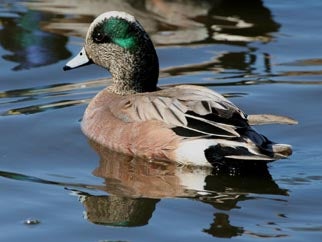SCIENTIFIC NAME:
American Wigeon (Anas americana) male.
OTHER NAMES:
Baldpate, robber duck, gray duck
STATUS:
Common in winter, spring, and fall, and occasional in summer in all regions. Low Conservation Concern.
DESCRIPTION:
American Wigeon (Anas americana) is a medium sized duck, averaging 19-20 inches in length and 1.75 lbs. in weight. They have relatively short, bluish gray bills with black tip, proportionately narrow wings and moderately long, wedge-shaped tails. The drakes have a distinct white crown which gives the duck its common name of baldpate. There is a green band that extends from the eye to the back of the head and a very distinctive white shoulder patch on the leading edge of the wing. The hen is a greatly dulled down version of the drake. When in flight, an elliptical white belly is sharply outlined in both sexes.
DISTRIBUTION:
Anas americana breeding range extends from the mixed prairie of the north-central United States, through the west-central portion of Canada and into the tundra of Alaska. Over three-fourths breed in the Canadian provinces of Saskatchewan, Albert, Manitoba and the Northwest Territories. During the winter, Anas americana disperse to the coastal marshes of the Gulf of America from Florida all the way around to the Yucatan Peninsula. They are also found in the Central Valley of California, the panhandle of Texas, the Mississippi River Valley and the eastern seaboard. Some do migrate as far as Cuba and the Dominican Republic in the Caribbean and along the western coastline of Mexico.
HABITAT:
The American Wigeon is a dabbling duck, meaning one that feeds by tipping face down in the water with its tail and feet upward as opposed to diving for its food. It prefers shallow water areas such as marshes and potholes. This is mainly because of their food preferences. However, wigeons will also utilize lakes, rivers and flooded agricultural lands.
FEEDING HABITS:
American Wigeons prefer the stems and leafy parts of aquatic plants, while most other dabbling ducks feed on the seeds of aquatic and cultivated plants. American Wigeons eat plants like eelgrass, wigeon grass, bushy pondweed and muskgrass from coastal estuaries. When foraging in fresh water lakes and ponds, they feed on pondweeds, coontail, wild celery and even filamentous algae. They will also utilize waste agricultural grains.
LIFE HISTORY:
American Wigeons begin to develop pair bonds as early as November and December. It is thought that most still wait until they reach the breeding grounds before they actually pair. The bond between the drake and the hen is short in duration, as the drake usually leaves within the first two weeks of incubation. The hen lays 6 to 12 creamy white eggs in a shallow depression lined with grass and feathers, beginning in early May into mid June. Incubation last 23 to 25 days and ducklings begin flying between 37 and 48 days. Staging for the fall migration begins in mid August for those in Alaska and Canada.
REFERENCES:
Bellrose, Frank C. 1976. Ducks, Geese and Swans of North America. Stackpole Books, Harrisburg, PA 543 pp.
Collins, Henry Hill Jr. 1981. Complete Field Guide to North American Wildlife. Harper and Row, Publishers, Inc. New York, NY 714 pp.
Author:
Mitchell Marks, Wildlife Biologist






